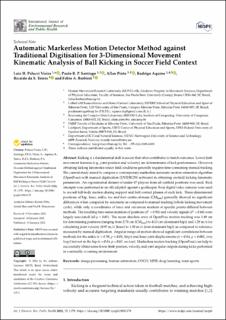| dc.contributor.author | Palucci Vieira, Luiz H. | |
| dc.contributor.author | Santiago, Paulo R P | |
| dc.contributor.author | Pinto, Allan | |
| dc.contributor.author | Aquino, Rodrigo | |
| dc.contributor.author | Torres, Ricardo | |
| dc.contributor.author | Barbieri, Fabio A. | |
| dc.date.accessioned | 2023-03-03T07:59:14Z | |
| dc.date.available | 2023-03-03T07:59:14Z | |
| dc.date.created | 2022-05-02T15:53:21Z | |
| dc.date.issued | 2022 | |
| dc.identifier.citation | International Journal of Environmental Research and Public Health (IJERPH). 2022, 19 (3), . | en_US |
| dc.identifier.issn | 1661-7827 | |
| dc.identifier.uri | https://hdl.handle.net/11250/3055594 | |
| dc.description.abstract | Kicking is a fundamental skill in soccer that often contributes to match outcomes. Lower limb movement features (e.g., joint position and velocity) are determinants of kick performance. However, obtaining kicking kinematics under field conditions generally requires time-consuming manual tracking. The current study aimed to compare a contemporary markerless automatic motion estimation algorithm (OpenPose) with manual digitisation (DVIDEOW software) in obtaining on-field kicking kinematic parameters. An experimental dataset of under-17 players from all outfield positions was used. Kick attempts were performed in an official pitch against a goalkeeper. Four digital video cameras were used to record full-body motion during support and ball contact phases of each kick. Three-dimensional positions of hip, knee, ankle, toe and foot centre-of-mass (CMfoot) generally showed no significant differences when computed by automatic as compared to manual tracking (whole kicking movement cycle), while only z-coordinates of knee and calcaneus markers at specific points differed between methods. The resulting time-series matrices of positions (r2 = 0.94) and velocity signals (r2 = 0.68) were largely associated (all p < 0.01). The mean absolute error of OpenPose motion tracking was 3.49 cm for determining positions (ranging from 2.78 cm (CMfoot) to 4.13 cm (dominant hip)) and 1.29 m/s for calculating joint velocity (0.95 m/s (knee) to 1.50 m/s (non-dominant hip)) as compared to reference measures by manual digitisation. Angular range-of-motion showed significant correlations between methods for the ankle (r = 0.59, p < 0.01, large) and knee joint displacements (r = 0.84, p < 0.001, very large) but not in the hip (r = 0.04, p = 0.85, unclear). Markerless motion tracking (OpenPose) can help to successfully obtain some lower limb position, velocity, and joint angular outputs during kicks performed in a naturally occurring environment. | en_US |
| dc.language.iso | eng | en_US |
| dc.publisher | MDPI | en_US |
| dc.rights | Navngivelse 4.0 Internasjonal | * |
| dc.rights.uri | http://creativecommons.org/licenses/by/4.0/deed.no | * |
| dc.title | Automatic Markerless Motion Detector Method against Traditional Digitisation for 3-Dimensional Movement Kinematic Analysis of Ball Kicking in Soccer Field Context | en_US |
| dc.title.alternative | Automatic Markerless Motion Detector Method against Traditional Digitisation for 3-Dimensional Movement Kinematic Analysis of Ball Kicking in Soccer Field Context | en_US |
| dc.type | Peer reviewed | en_US |
| dc.type | Journal article | en_US |
| dc.description.version | publishedVersion | en_US |
| dc.source.volume | 19 | en_US |
| dc.source.journal | International Journal of Environmental Research and Public Health (IJERPH) | en_US |
| dc.source.issue | 3 | en_US |
| dc.identifier.doi | 10.3390/ijerph19031179 | |
| dc.identifier.cristin | 2020783 | |
| cristin.ispublished | true | |
| cristin.fulltext | original | |
| cristin.qualitycode | 1 | |

